Design and Development of Array POS for Airborne Remote Sensing Motion Compensation
Abstract
:1. Introduction
2. Materials and Methods
2.1. Component and Layout of Array POS
2.2. Transfer Alignment Method Based on 6-D Deformation
2.2.1. Relative Inertial Navigation Algorithm
2.2.2. 6-D Deformation Method
- Strain Measurement Principle of FBG Sensors
- 2
- Strain Decoupling Approach
- 3
- Bending Model
- 4
- Torsion Model
- 5
- 6-D Deformation Model
2.2.3. Kalman Filter Based on Relative Navigation
2.3. Motion Conversion Method from Array POS to Array SAR
2.3.1. Relative Motion between Antennas
2.3.2. Multi-Antenna Motion
3. Results
3.1. Experimental Equipment
3.2. Experiment Results
4. Conclusions
Author Contributions
Funding
Data Availability Statement
Conflicts of Interest
References
- Zhu, Z.; Li, C.; Zhou, X. An Accurate High-Order Errors Suppression and Cancellation Method for High-Precision Airborne POS. IEEE Trans. Geosci. Remote Sens. 2018, 56, 5357–5367. [Google Scholar] [CrossRef]
- Artés, F.; Hutton, J. GPS and Inertial Navigation-Delivering. GEOconnexion Int. Mag. 2005, 4, 52–53. [Google Scholar]
- Jiang, S.; Jiang, W. On-Board GNSS/IMU Assisted Feature Extraction and Matching for Oblique UAV Images. Remote Sens. 2017, 9, 813. [Google Scholar] [CrossRef] [Green Version]
- Scheninger, B.M.; Hutton, J.J.; McMillan, J.C. Low Cost Inertial/GPS Integrated Position and Orientation System for Marine Applications. IEEE Aerosp. Electron. Syst. Mag. 1997, 12, 15–19. [Google Scholar] [CrossRef]
- Fang, J.; Chen, L.; Yao, J. An Accurate Gravity Compensation Method for High-Precision Airborne POS. IEEE Trans. Geosci. Remote Sens. 2014, 52, 4564–4573. [Google Scholar] [CrossRef]
- Reulke, R.; Wehr, A.; Griesbach, D. Mobile Panoramic Mapping Using CCD-Line Camera and Laser Scanner with Integrated Position and Orientation System. In Imaging beyond the Pinhole Camera; Daniilidis, K., Klette, R., Eds.; Springer: Dordrecht, The Netherlands, 2006; Volume 33, pp. 165–183. [Google Scholar]
- Li, X.; Zhang, F.; Liang, X.; Li, Y.; Guo, Q.; Wan, Y.; Bu, X.; Liu, Y. Fourfold Bounce Scattering-Based Reconstruction of Building Backs Using Airborne Array TomoSAR Point Clouds. Remote Sens. 2022, 14, 1937. [Google Scholar] [CrossRef]
- Tan, K.; Wu, S.; Liu, X.; Fang, G. Omega-K Algorithm for Near-Field 3-D Image Reconstruction Based on Planar SIMO/MIMO Array. IEEE Trans. Geosci. Remote Sens. 2019, 57, 2381–2394. [Google Scholar] [CrossRef]
- Zhu, X.; Wang, Y.; Montazeri, S.; Ge, N. A Review of Ten-Year Advances of Multi-Baseline SAR Interferometry Using TerraSAR-X Data. Remote Sens. 2018, 10, 1374. [Google Scholar] [CrossRef] [Green Version]
- Yang, G.; Li, C.; Wu, S.; Zheng, S.; Liu, X.; Fang, G. Phase Shift Migration with Modified Coherent Factor Algorithm for MIMO-SAR 3D Imaging in THz Band. Remote Sens. 2021, 13, 4701. [Google Scholar] [CrossRef]
- Li, X.; Zhang, F.; Li, Y.; Guo, Q.; Wan, Y.; Bu, X.; Liu, Y.; Liang, X. An Elevation Ambiguity Resolution Method Based on Segmentation and Reorganization of TomoSAR Point Cloud in 3D Mountain Reconstruction. Remote Sens. 2021, 13, 5118. [Google Scholar] [CrossRef]
- Franceschetti, G.; Iodice, A.; Maddaluno, S.; Riccio, D. Effect of Antenna Mast Motion on X-SAR/SRTM Performance. IEEE Trans. Geosci. Remote Sens. 2000, 38, 2361–2372. [Google Scholar] [CrossRef]
- Wang, B.; Xiang, M.; Chen, L. Motion Compensation on Baseline Oscillations for Distributed Array SAR by Combining Interferograms and Inertial Measurement. IET Radar Sonar Navig. 2017, 11, 1285–1291. [Google Scholar] [CrossRef]
- Li, D.; Teng, X.; Pan, Z. The Concept and Applications of Distributed POS. J. Radars 2014, 2, 400–405. [Google Scholar] [CrossRef]
- Wheeler, K.; Hensley, S. The GeoSAR Airborne Mapping System. In Proceedings of the Record of the IEEE 2000 International Radar Conference, Alexandria, VA, USA, 12 May 2000; pp. 831–835. [Google Scholar]
- Iwasaki, Y. A Method of Robust Moving Vehicle Detection for Bad Weather Using an Infrared Thermography Camera. In Proceedings of the 2008 International Conference on Wavelet Analysis and Pattern Recognition, Hong Kong, China, 30–31 August 2008; pp. 86–90. [Google Scholar]
- Boukhriss, R.R. Moving Object Detection under Different Weather Conditions Using Full-Spectrum Light Sources. Pattern Recognition Letters 2020, 129, 205–212. [Google Scholar] [CrossRef]
- Zou, S.; Li, J.; Lu, Z.; Liu, Q.; Fang, J. A Nonlinear Transfer Alignment of Distributed POS Based on Adaptive Second-Order Divided Difference Filter. IEEE Sens. J. 2018, 18, 9612–9618. [Google Scholar] [CrossRef]
- Lu, Z.; Fang, J.; Liu, H.; Gong, X.; Wang, S. Dual-Filter Transfer Alignment for Airborne Distributed POS Based on PVAM. Aerospace Sci. Technol. 2017, 71, 136–146. [Google Scholar] [CrossRef]
- Gong, X.; Chen, L.; Fang, J.; Liu, G. A Transfer Alignment Method for Airborne Distributed POS with Three-Dimensional Aircraft Flexure Angles. Sci. China Inf. Sci. 2018, 61, 092204. [Google Scholar] [CrossRef] [Green Version]
- Pak, C. Wing Shape Sensing from Measured Strain. AIAA J. 2016, 54, 1068–1077. [Google Scholar] [CrossRef] [Green Version]
- Freydin, M.; Rattner, M.K.; Raveh, D.E.; Kressel, I.; Davidi, R.; Tur, M. Fiber-Optics-Based Aeroelastic Shape Sensing. AIAA J. 2019, 57, 5094–5103. [Google Scholar] [CrossRef]
- Klotz, T.; Pothier, R.; Walch, D.; Colombo, T. Prediction of the Business Jet Global 7500 Wing Deformed Shape Using Fiber Bragg Gratings and Neural Network. Results Eng. 2021, 9, 100190. [Google Scholar] [CrossRef]
- Kefal, A.; Tabrizi, I.E.; Yildiz, M.; Tessler, A. A Smoothed IFEM Approach for Efficient Shape-Sensing Applications: Numerical and Experimental Validation on Composite Structures. Mech. Syst. Signal. Process. 2021, 152, 107486. [Google Scholar] [CrossRef]
- Mieloszyk, M.; Majewska, K.; Zywica, G.; Kaczmarczyk, T.Z.; Jurek, M.; Ostachowicz, W. Fibre Bragg Grating Sensors as a Measurement Tool for an Organic Rankine Cycle Micro-Turbogenerator. Measurement 2020, 157, 107666. [Google Scholar] [CrossRef]
- El-Gammal, H.M.; Ismail, N.E.; Rizk, M.R.M.; Aly, M.H. Strain Sensing in Underwater Acoustics with a Hybrid π-Shifted FBG and Different Interrogation Methods. Opt Quant. Electron. 2022, 54, 226. [Google Scholar] [CrossRef]
- Deepa, S.; Das, B. Interrogation Techniques for π-Phase-Shifted Fiber Bragg Grating Sensor: A Review. Sens. Actuat. A Phys. 2020, 315, 112215. [Google Scholar] [CrossRef]
- Li, J.; Qu, C.; Zhu, Z.; Gong, X.; Sun, Y.; Li, Y.; Chen, Z. Six-Dimensional Deformation Measurement of Distributed POS Based on FBG Sensors. IEEE Sens. J. 2021, 21, 7849–7856. [Google Scholar] [CrossRef]
- Fajkus, M.; Kovar, P.; Skapa, J.; Nedoma, J.; Martinek, R.; Vasinek, V. Design of Fiber Bragg Grating Sensor Networks. IEEE Trans. Instrum. Meas. 2022, 71, 1–11. [Google Scholar] [CrossRef]
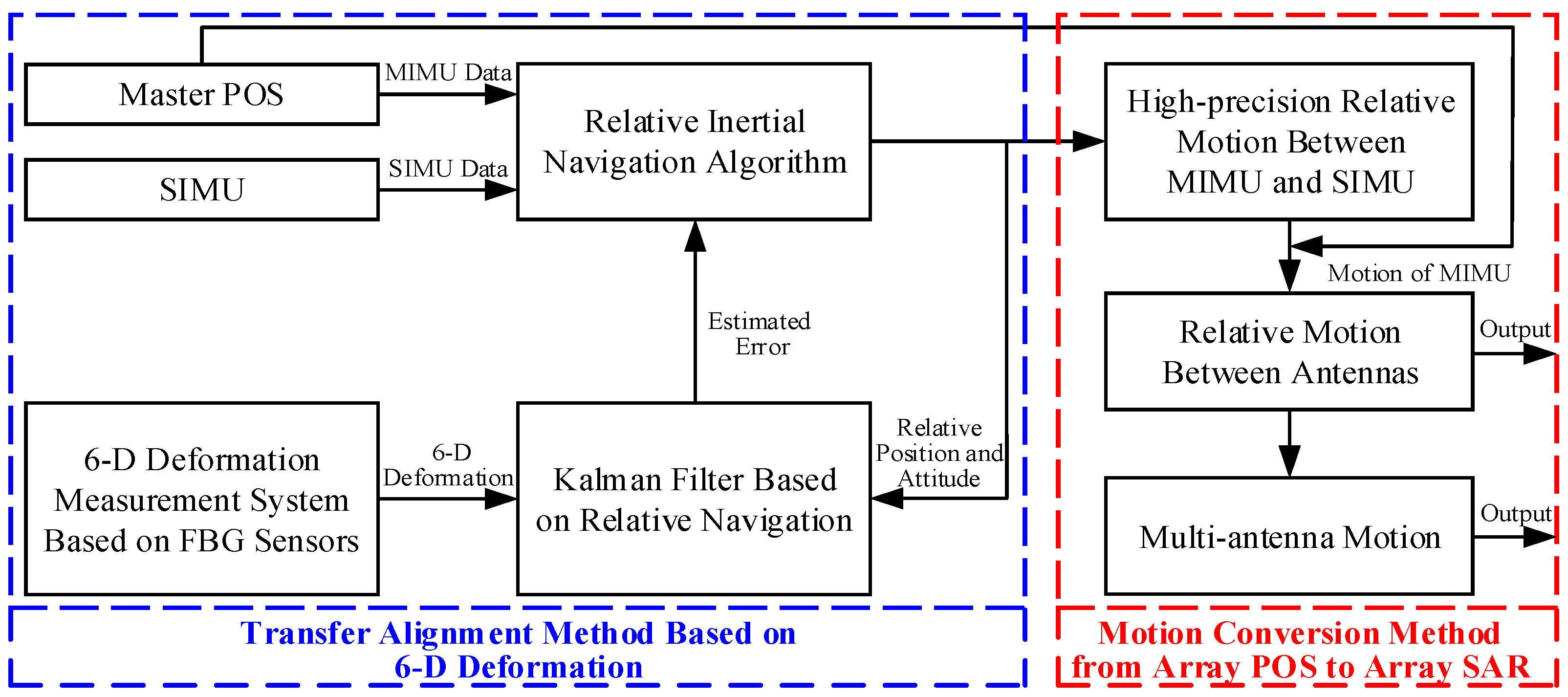
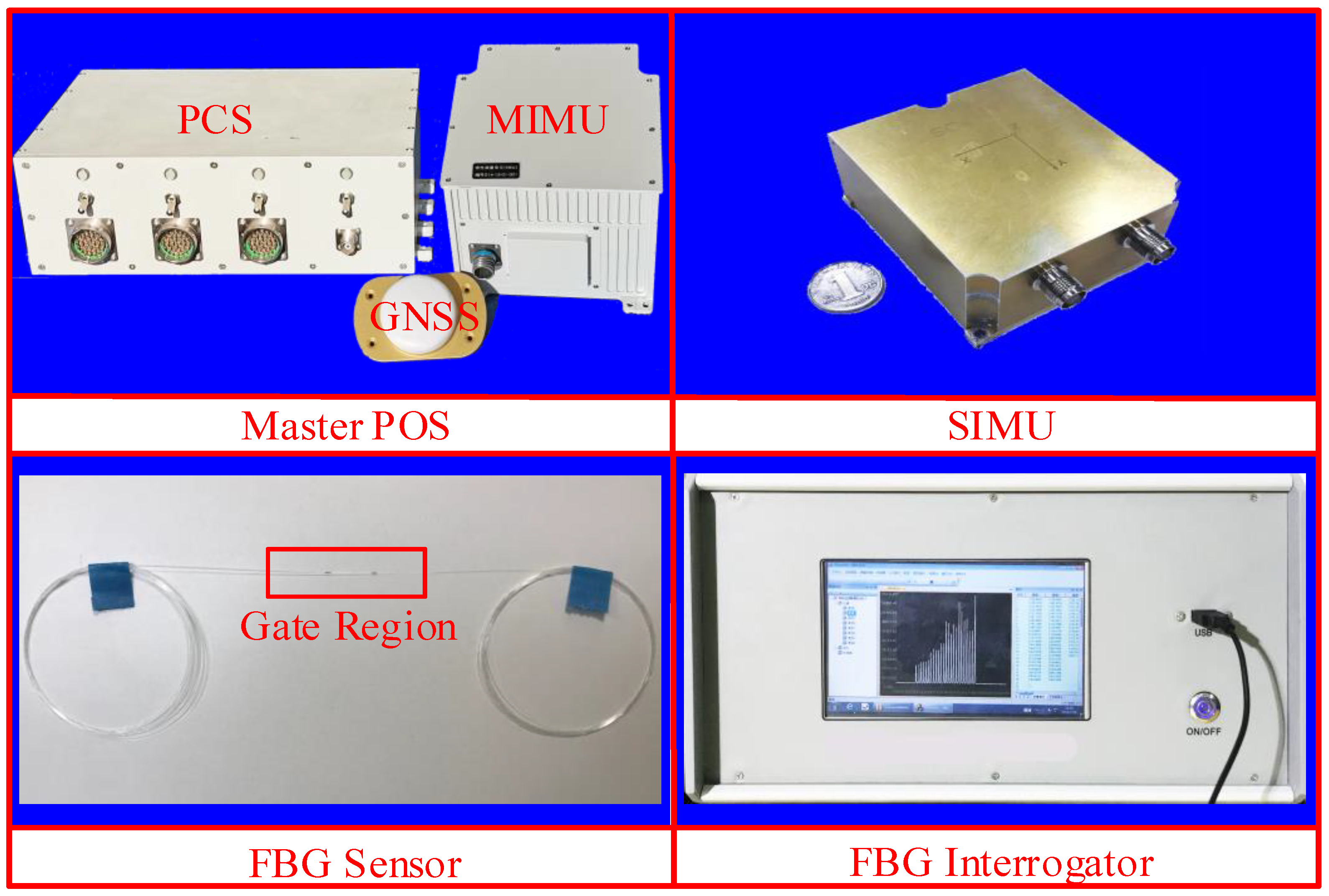
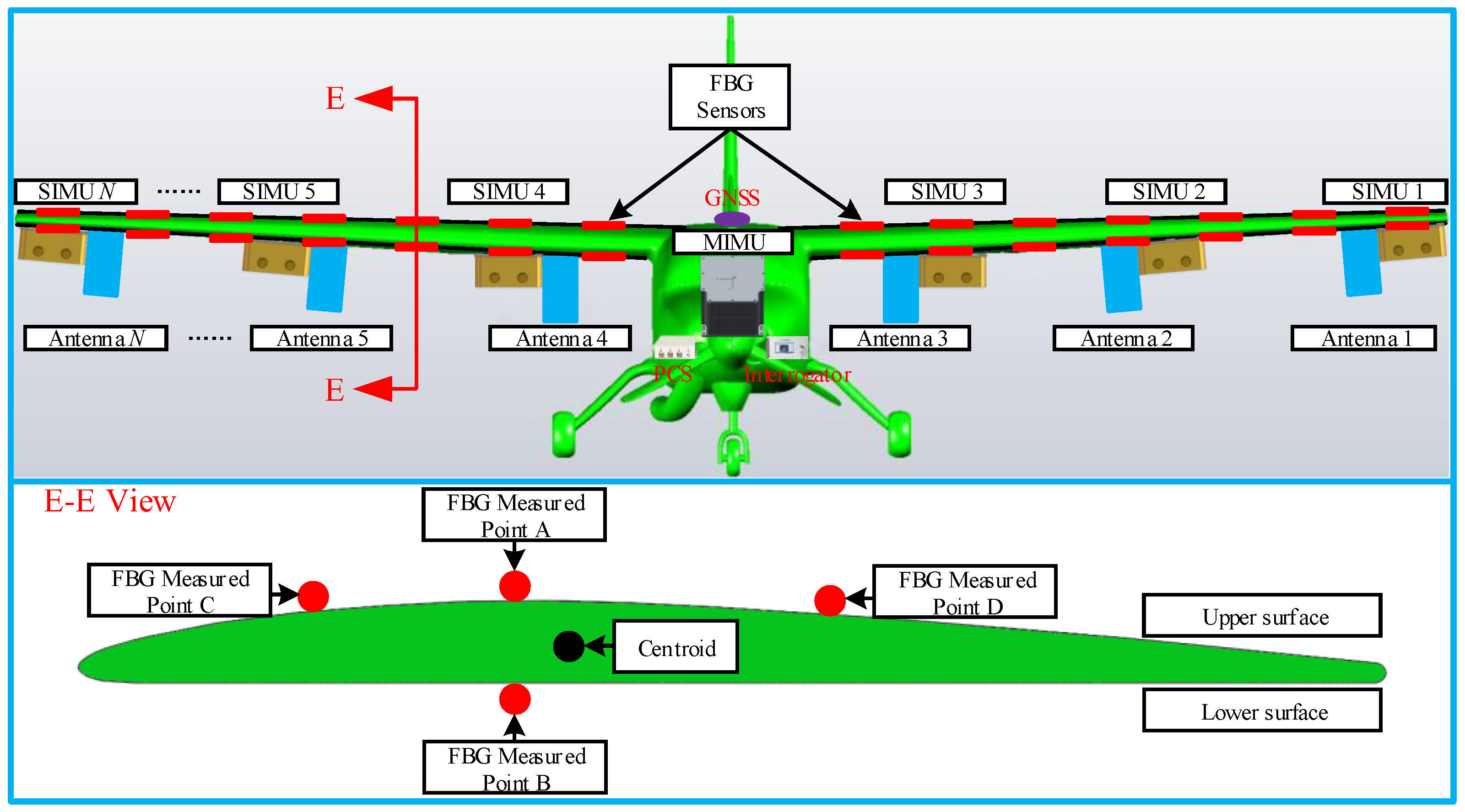

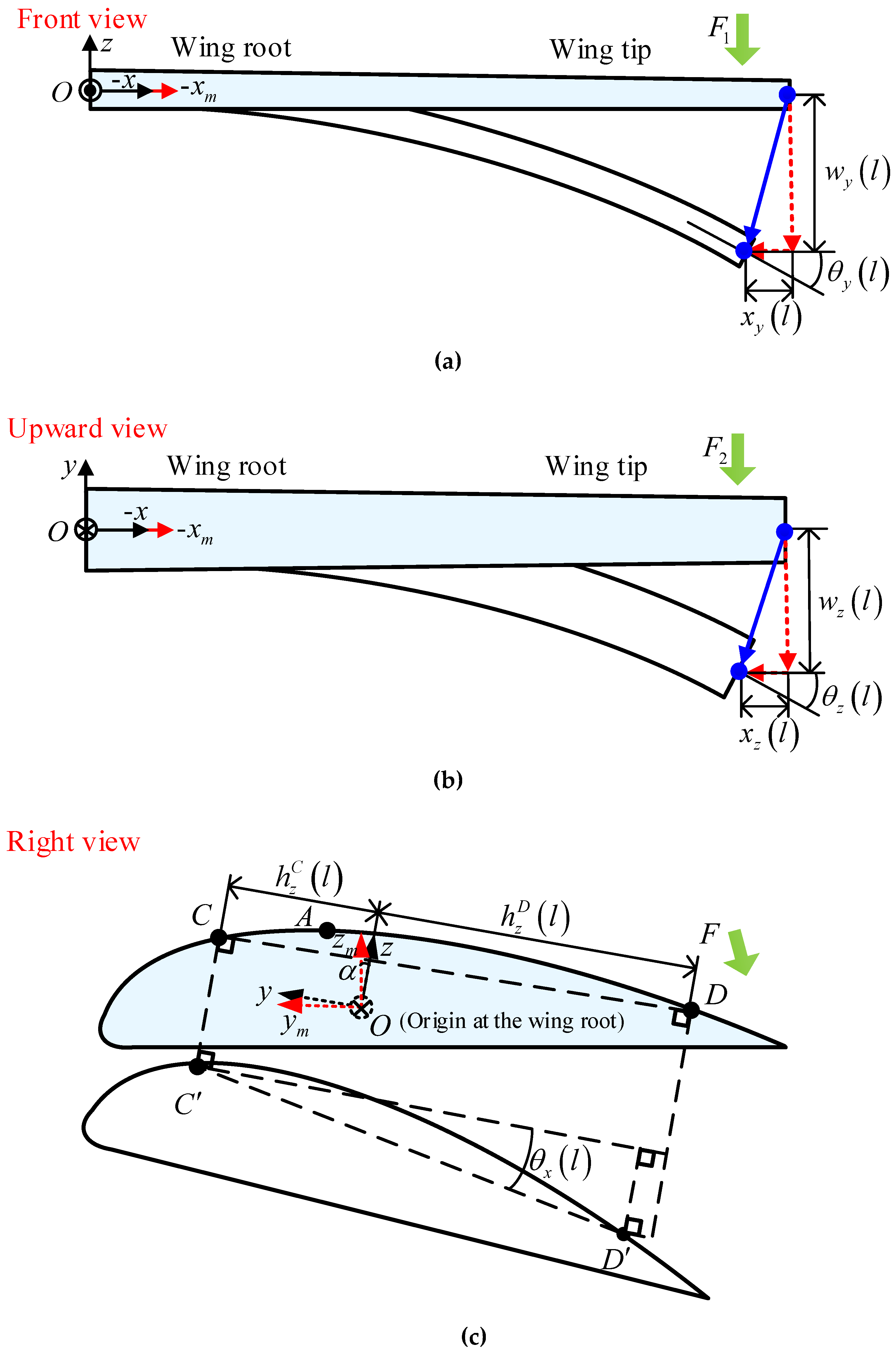



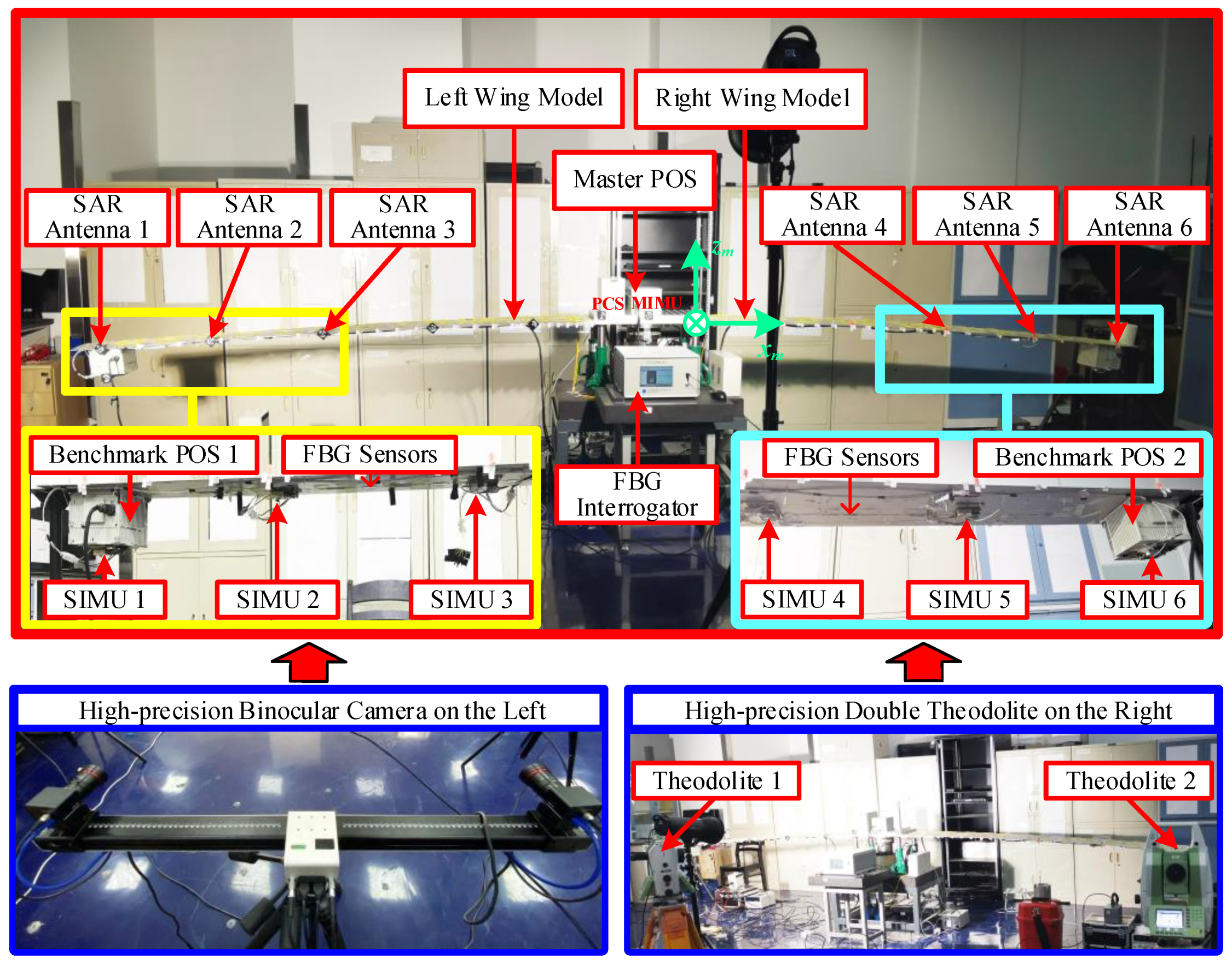

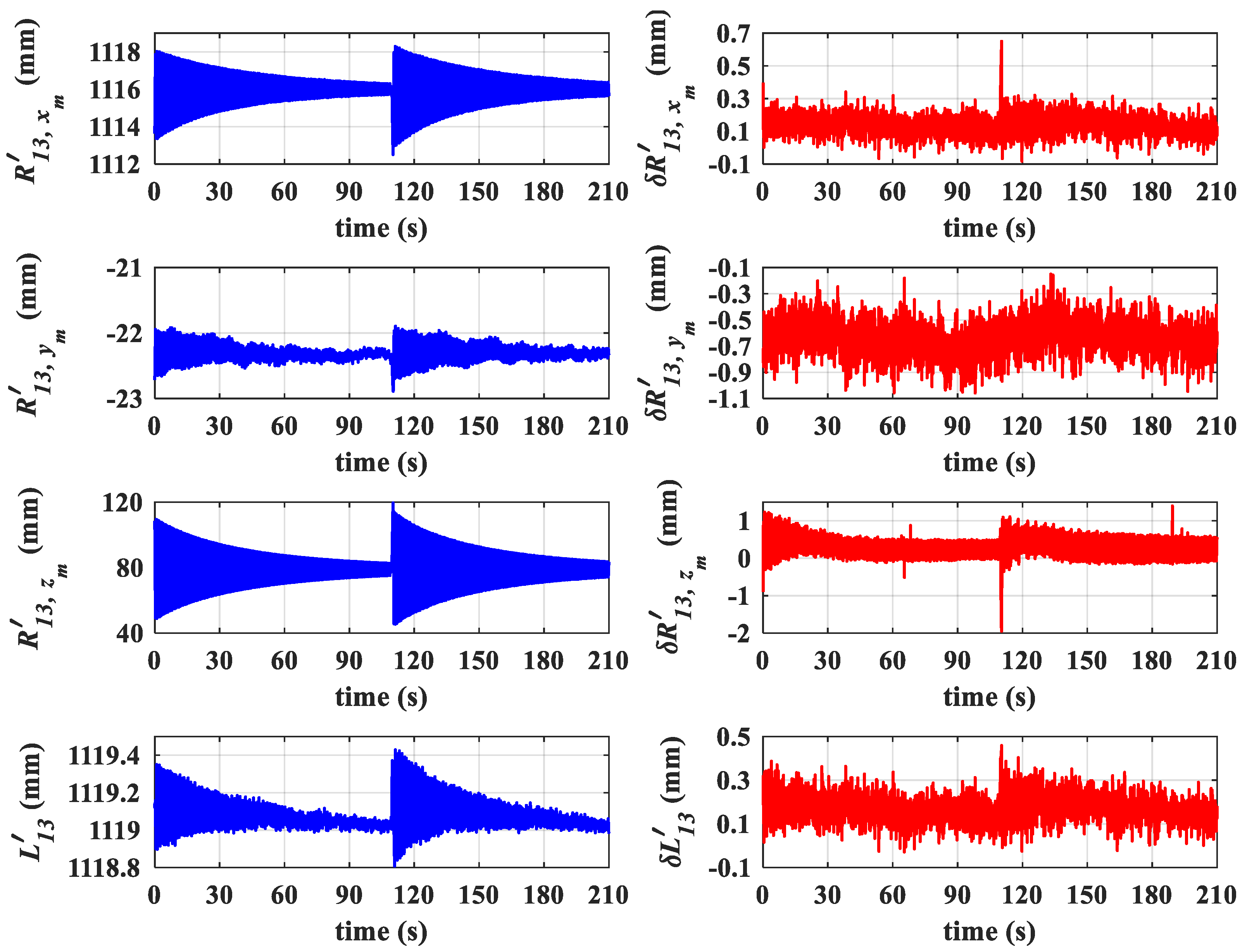
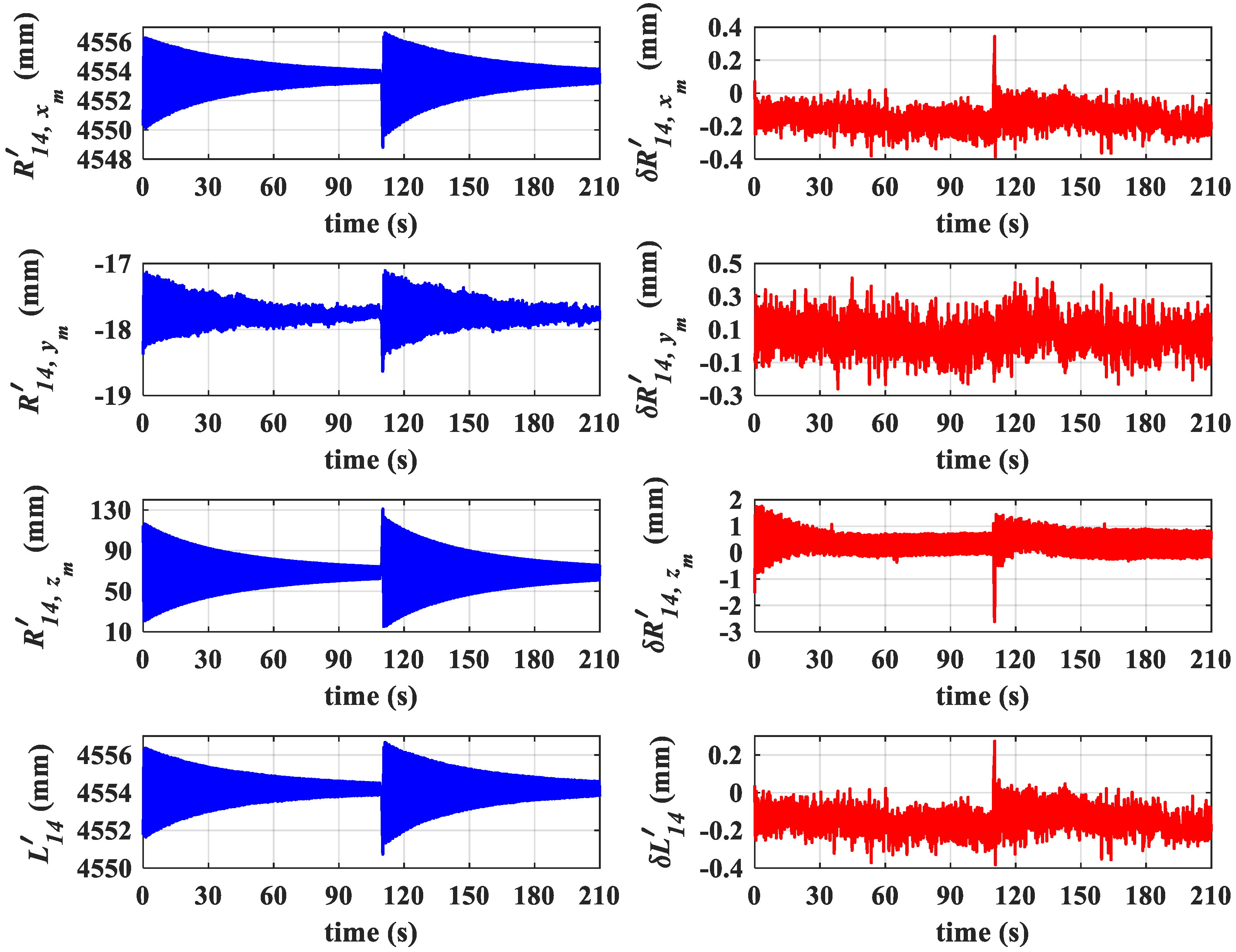

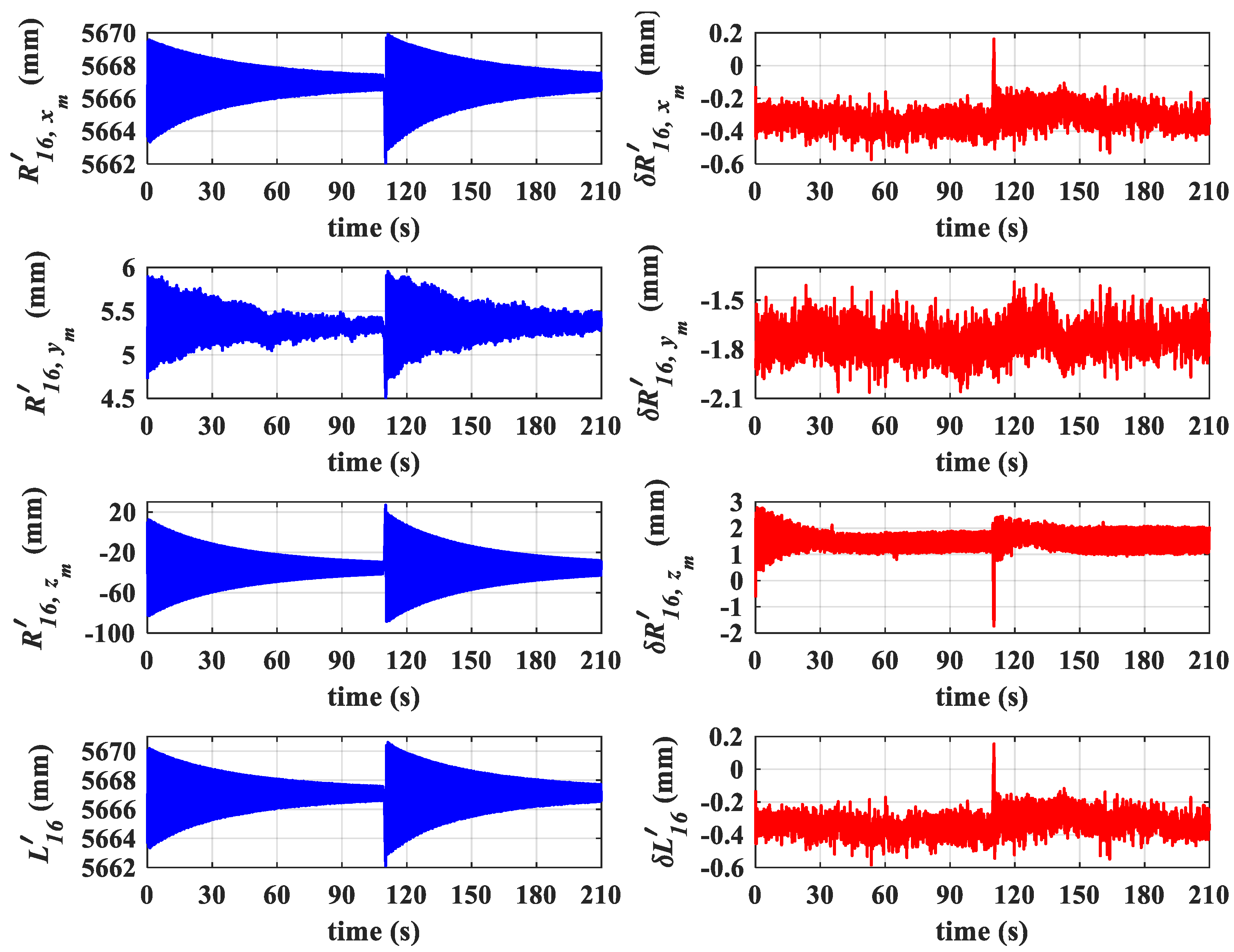

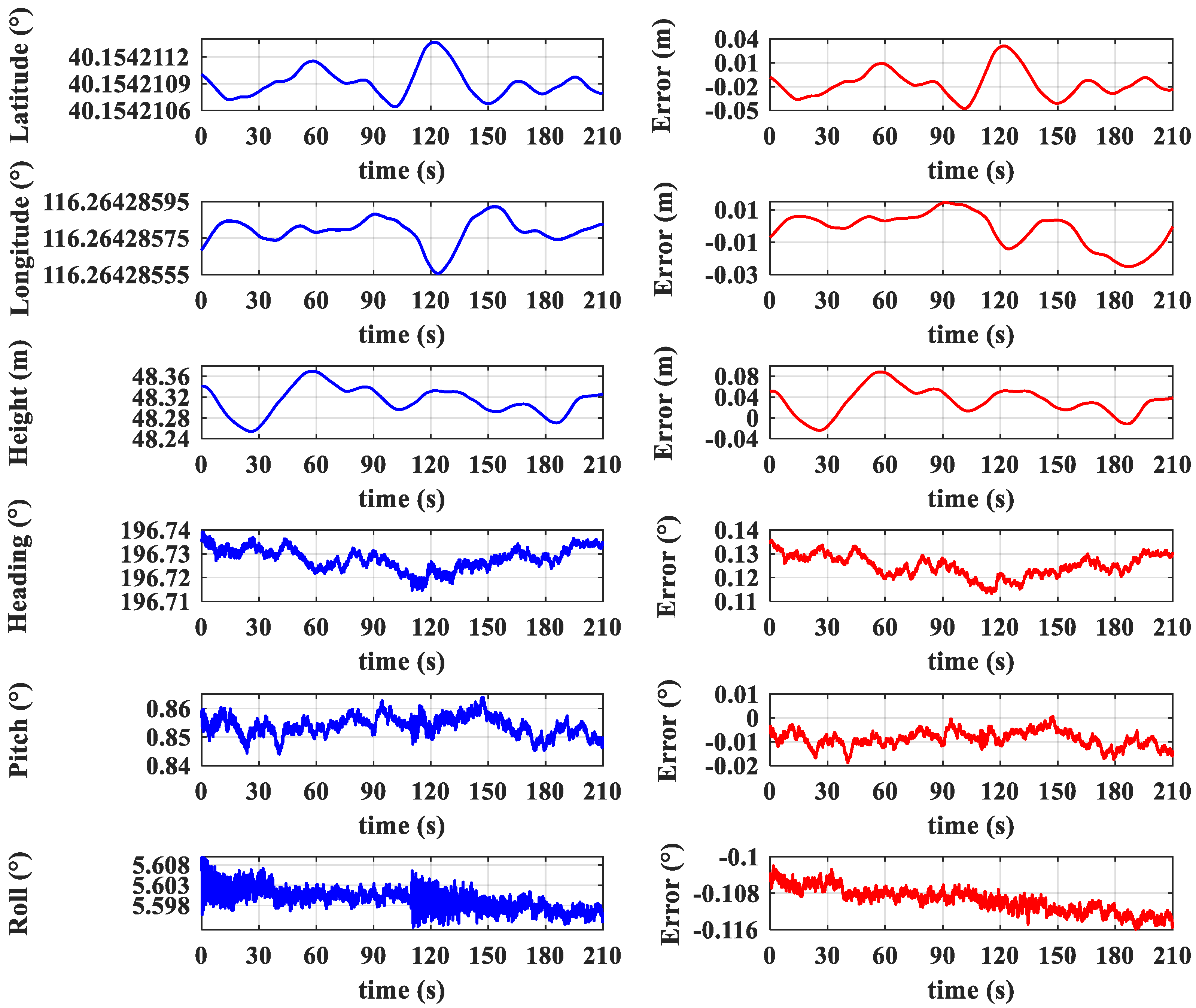
| Antennas | 1 and 2 | 1 and 3 | 1 and 4 | 1 and 5 | 1 and 6 |
|---|---|---|---|---|---|
| Initial baseline length (m) | 0.5 | 1.1 | 4.5 | 5.1 | 5.6 |
| Loading steps | 1st | 2nd | 3rd |
|---|---|---|---|
| Right wing (Static load) | 1 kg | 3 kg | 5 kg |
| Left wing (Pulse load) | 1 kg (twice) | 3 kg (twice) | 5 kg (twice) |
| Times | 210 s | 160 s | 210 s |
| Antennas | Relative Position (mm) | Baseline Length (mm) | |||
|---|---|---|---|---|---|
| 1st | 1 and 2 | 0.05 | 0.11 | 0.1 | 0.05 |
| 1 and 3 | 0.05 | 0.11 | 0.17 | 0.05 | |
| 1 and 4 | 0.05 | 0.09 | 0.26 | 0.05 | |
| 1 and 5 | 0.05 | 0.08 | 0.26 | 0.05 | |
| 1 and 6 | 0.05 | 0.09 | 0.26 | 0.05 | |
| 2nd | 1 and 2 | 0.06 | 0.12 | 0.14 | 0.06 |
| 1 and 3 | 0.05 | 0.12 | 0.24 | 0.06 | |
| 1 and 4 | 0.06 | 0.09 | 0.33 | 0.06 | |
| 1 and 5 | 0.06 | 0.09 | 0.31 | 0.06 | |
| 1 and 6 | 0.06 | 0.08 | 0.3 | 0.06 | |
| 3rd | 1 and 2 | 0.07 | 0.12 | 0.18 | 0.06 |
| 1 and 3 | 0.06 | 0.13 | 0.28 | 0.06 | |
| 1 and 4 | 0.06 | 0.09 | 0.41 | 0.06 | |
| 1 and 5 | 0.06 | 0.09 | 0.39 | 0.06 | |
| 1 and 6 | 0.07 | 0.09 | 0.38 | 0.07 | |
| Maximum | 0.07 | 0.13 | 0.41 | 0.07 | |
| Antenna | Position (m) | Attitude (°) | |||||
|---|---|---|---|---|---|---|---|
| Latitude | Longitude | Height | Heading | Pitch | Roll | ||
| 1st | 1 | 0.01 | 0.01 | 0.01 | 0.004 | 0.003 | 0.002 |
| 6 | 0.01 | 0.01 | 0.01 | 0.008 | 0.003 | 0.002 | |
| 2nd | 1 | 0.01 | 0.01 | 0.03 | 0.006 | 0.006 | 0.007 |
| 6 | 0.01 | 0.01 | 0.02 | 0.004 | 0.003 | 0.001 | |
| 3rd | 1 | 0.02 | 0.01 | 0.03 | 0.006 | 0.007 | 0.008 |
| 6 | 0.02 | 0.01 | 0.03 | 0.005 | 0.003 | 0.003 | |
| Maximum | 0.02 | 0.01 | 0.03 | 0.008 | 0.007 | 0.008 | |
Publisher’s Note: MDPI stays neutral with regard to jurisdictional claims in published maps and institutional affiliations. |
© 2022 by the authors. Licensee MDPI, Basel, Switzerland. This article is an open access article distributed under the terms and conditions of the Creative Commons Attribution (CC BY) license (https://creativecommons.org/licenses/by/4.0/).
Share and Cite
Qu, C.; Li, J.; Bao, J.; Zhu, Z. Design and Development of Array POS for Airborne Remote Sensing Motion Compensation. Remote Sens. 2022, 14, 3420. https://doi.org/10.3390/rs14143420
Qu C, Li J, Bao J, Zhu Z. Design and Development of Array POS for Airborne Remote Sensing Motion Compensation. Remote Sensing. 2022; 14(14):3420. https://doi.org/10.3390/rs14143420
Chicago/Turabian StyleQu, Chunyu, Jianli Li, Junfang Bao, and Zhuangsheng Zhu. 2022. "Design and Development of Array POS for Airborne Remote Sensing Motion Compensation" Remote Sensing 14, no. 14: 3420. https://doi.org/10.3390/rs14143420







